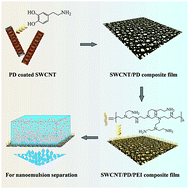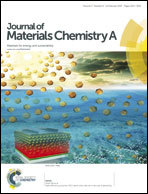Superwetting polymer-decorated SWCNT composite ultrathin films for ultrafast separation of oil-in-water nanoemulsions†
Abstract
Functional membranes with a superwetting surface property have been extensively explored to achieve oil–water separation. Here, single-walled carbon nanotube/polydopamine/polyethyleneimine (SWCNT/PD/PEI) composite ultrathin films which have superhydrophilic and underwater superoleophobic properties were successfully prepared and used for the ultrafast separation of surfactant-stabilized oil-in-water nanoemulsions containing oil droplets of tens of nanometers. A SWCNT/PD/PEI composite film with an effective pore size of ∼10 nm and a thickness of ∼160 nm can effectively separate oil-in-water nanoemulsions in an ultrafast manner with fluxes up to ∼6000 L m−2 h−1 bar−1, which is 10-fold higher than traditional ultrafiltration membranes with a similar rejection property. Meanwhile, this film exhibits excellent pH-stability and antifouling property. This work points a direction for designing and fabricating ultrathin and superwetting films for the effective separation of oil-in-water nanoemulsions or nano-sized oils which are hard to separate by traditional methods. The SWCNT/PD/PEI ultrathin film holds promising potential for purifying emulsified wastewater from industries and daily life and for drinking water treatment.


 Please wait while we load your content...
Please wait while we load your content...